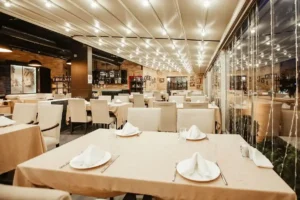Restaurant Supplies: A Comprehensive Guide to Essential Equipment and Tools for Running a Successful Restaurant
Running a successful restaurant requires more than just a great menu and skilled chefs. It demands careful planning and investment in high-quality restaurant supplies to ensure smooth operations, a clean environment, and a delightful dining experience for customers. Whether you’re opening a new restaurant or managing an existing one, the right restaurant supplies can make a significant difference in your overall performance and customer satisfaction.
In this comprehensive guide, we will explore the key restaurant supplies that are essential for both front-of-house and back-of-house operations. From kitchen equipment to dining furniture, we’ll cover the various categories and provide insights into how to select the best supplies for your restaurant.
1. Importance of Restaurant Supplies
Restaurant supplies refer to the tools, equipment, and ingredients needed to run a foodservice establishment efficiently. These supplies are essential for a variety of reasons:
- Operational Efficiency: With the right equipment and tools, restaurant operations run smoothly, minimizing errors and delays in food preparation, service, and customer satisfaction.
- Food Quality: The quality of the food being prepared and served heavily depends on the quality of the kitchen supplies, such as utensils, cooking equipment, and storage solutions.
- Safety and Hygiene: Proper restaurant supplies ensure a safe and hygienic environment for both staff and customers. This includes cleaning supplies, storage containers, and safety equipment like fire extinguishers.
- Customer Experience: The type and quality of dining furniture, cutlery, and decor play a significant role in shaping the overall dining experience.
Let’s take a closer look at the essential supplies you need in various categories for your restaurant.
2. Back-of-House Restaurant Supplies
The back-of-house refers to the areas of the restaurant where food preparation and cooking take place. This includes the kitchen, storage, and dishwashing areas. Having the right back-of-house supplies is crucial for ensuring food quality, efficiency, and safety.
2.1 Kitchen Equipment
Kitchen equipment is the backbone of any restaurant. These supplies are used to prepare, cook, store, and present food. Here are some of the most important kitchen equipment items:
a. Cooking Appliances
- Ranges and Stoves: Ranges and stoves are necessary for preparing a wide range of dishes, from grilled meats to sauces and stir-fries. Depending on the size of your restaurant, you may need a commercial range with multiple burners or an induction stove for energy efficiency.
- Ovens: Ovens are essential for baking, roasting, and broiling. Common options include conventional ovens, convection ovens, and pizza ovens, depending on your menu offerings.
- Fryers: If your restaurant serves fried foods such as fries, chicken, or donuts, deep fryers are a must-have. They come in various sizes and capacities to suit different volumes of food preparation.
- Grills and Griddles: These appliances are perfect for cooking burgers, steaks, and other grilled items. Commercial grills often offer adjustable heat zones and even cooking surfaces.
b. Refrigeration Units
Proper refrigeration is vital for maintaining the freshness and safety of food ingredients. Common refrigeration equipment includes:
- Reach-in Refrigerators: These are standard for storing ingredients in the kitchen, and they come in single, double, or triple-door options.
- Walk-in Coolers/Freezers: Walk-in coolers and freezers are essential for larger restaurants with high-volume storage needs. They provide ample space for storing perishable items and can be customized to fit your needs.
- Undercounter Refrigerators: These compact refrigeration units are perfect for keeping frequently used ingredients at arm’s reach.
c. Prep Equipment
Efficient food prep is essential for fast service. Some important prep equipment includes:
- Food Processors: Food processors save time by chopping, slicing, and pureeing ingredients in seconds.
- Mixers: If you prepare dough, batters, or sauces in large quantities, commercial mixers are indispensable.
- Cutting Boards and Knives: High-quality cutting boards and chef’s knives are essential for safe and efficient food preparation.
- Blenders and Juicers: These are crucial for making soups, smoothies, sauces, and fresh juices.
d. Smallwares
Smallwares refer to smaller kitchen tools and utensils that assist with food preparation. Some common smallwares include:
- Measuring Cups and Spoons: Accurate measurements are crucial for consistency in recipes and food preparation.
- Tongs, Ladles, and Spatulas: These tools are necessary for flipping, stirring, and serving food.
- Spoons, Whisks, and Colanders: These tools help with mixing, straining, and preparing food in various ways.
2.2 Storage and Organization
Efficient storage is key to keeping your kitchen organized, reducing waste, and ensuring the proper handling of food. Important storage supplies include:
a. Shelving and Racks
Commercial shelving systems allow you to store ingredients, kitchen supplies, and utensils in an organized manner. These can be made from stainless steel for durability and ease of cleaning.
b. Storage Containers
A wide range of containers, including plastic bins, glass jars, and airtight food storage containers, are essential for storing ingredients and leftovers while maintaining food safety.
c. Dry Storage Areas
You’ll need dedicated space for dry goods like flour, spices, and canned goods. Proper ventilation and pest control measures should be in place to maintain the integrity of your ingredients.
2.3 Dishwashing Equipment
Efficient dishwashing is essential to maintaining cleanliness and ensuring that dishes, utensils, and cooking tools are sanitized. Key dishwashing supplies include:
a. Commercial Dishwashers
A commercial dishwasher is essential for washing large volumes of dishes efficiently. These dishwashers are designed to handle high temperatures and heavy-duty cleaning.
b. Sinks
Three-compartment sinks are often required for washing, rinsing, and sanitizing dishes. Separate sinks for handwashing and food preparation are also necessary for maintaining hygiene standards.
c. Cleaning Supplies
Regular cleaning is crucial to maintain a sanitary kitchen environment. Cleaning supplies include dish soap, sanitizers, degreasers, sponges, scrub brushes, and mops.
3. Front-of-House Restaurant Supplies
The front-of-house encompasses areas where customers dine, such as the dining room, bar, and waiting areas. Here, customer experience plays a central role in determining the success of the restaurant. The right front-of-house supplies can enhance the ambiance, improve service, and make the dining experience more enjoyable.
3.1 Dining Furniture
The furniture in your restaurant should align with your brand and create a comfortable dining environment. Key furniture items include:
- Tables and Chairs: The size and style of your tables and chairs will depend on your restaurant’s concept. For example, a fine-dining restaurant may use elegant tables with plush chairs, while a casual eatery may opt for modern, minimalist designs.
- Booths and Banquettes: These provide customers with a more private, intimate seating experience and are often used in casual or family-oriented restaurants.
- Barstools: If your restaurant has a bar area, consider investing in high-quality barstools that offer comfort and support for patrons.
- Outdoor Furniture: If you have an outdoor dining space, you’ll need weather-resistant furniture like patio tables, chairs, and umbrellas to keep customers comfortable.
3.2 Tableware
The tableware used in your restaurant can impact the overall presentation and dining experience. Key tableware items include:
- Plates, Bowls, and Platters: Choose high-quality ceramic, porcelain, or glassware that complements your menu and theme.
- Glassware: Glassware, such as wine glasses, water glasses, and cocktail glasses, is essential for offering a variety of beverages.
- Cutlery: Invest in durable, stylish cutlery that enhances the dining experience. This includes knives, forks, spoons, and serving utensils.
- Serving Dishes and Trays: These are used to present food attractively and serve it to customers.
3.3 Bar Supplies
For restaurants that serve alcohol, having the right bar supplies is essential for smooth operations. Some common bar supplies include:
- Cocktail Shakers: These are used for mixing drinks and creating signature cocktails.
- Bar Tools: Essential tools include jiggers, strainers, muddles, and bottle openers.
- Ice Makers and Coolers: An ice maker is necessary for creating the right amount of ice for drinks, and coolers keep drinks at the ideal temperature.
- Glassware for Drinks: Specialized glassware like martini glasses, pint glasses, and wine glasses can elevate the drinking experience.
3.4 Point of Sale (POS) Systems
A POS system helps streamline the ordering and payment process. It tracks orders, manages inventory, processes payments, and generates reports, all of which are essential for efficient front-of-house operations.
4. Conclusion
Restaurant supplies are essential for creating an efficient, safe, and enjoyable dining experience for customers. From kitchen equipment that ensures food quality to dining furniture that enhances ambiance, the right supplies can make a significant difference in your restaurant’s success. By carefully selecting the best supplies for both back-of-house and front-of-house operations, you can ensure that your restaurant runs smoothly, your food is of the highest quality, and your customers have an exceptional dining experience.
Whether you’re opening a new restaurant or updating an existing one, investing in quality restaurant supplies is a critical step toward building a lasting and thriving business.













